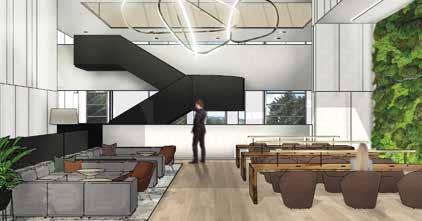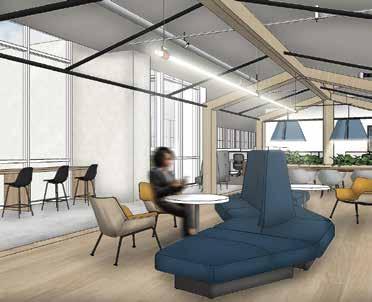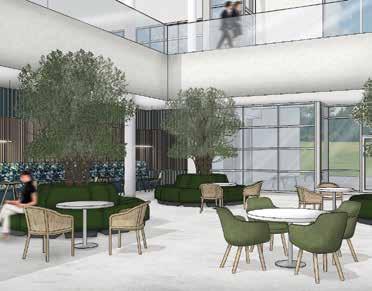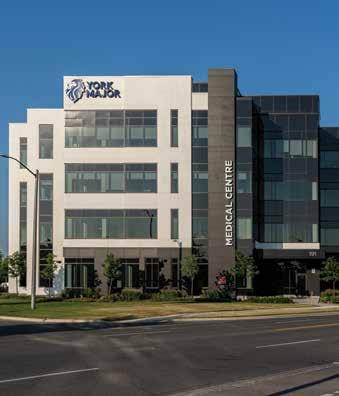
4 minute read
CO-OPERATORS EARNS ZERO CARBON CERTIFICATION FOR CORPORATE HEADQUARTERS
Guelph head office will embody the future of sustainable, climate-conscious building design in Canada
With construction well underway, Co-operators new head office in Guelph, ON has earned Zero Carbon Building –Design Standard certification from the Canada Green Building Council (CAGBC).
Advertisement
When it opens in the summer of 2024, the 226,000 sq. ft facility at 101 Cooper Drive in Guelph will feature an all-electric design that will eliminate direct carbon emissions from any onsite source, meaning no retrofits or decarbonization plan will be required as the organization progresses toward its net zero targets. The building will be highly energy-efficient and minimize indirect annual carbon emissions from electricity, offsetting any remaining emissions through high-quality carbon offsets or carbon-free renewable energy. In addition, ‘embodied carbon’ emissions resulting from construction, manufacturing, transportation and disposal of all building materials are also meaningfully reduced or offset.
According to the Canada Green Building Council, the building sector is Canada‘s third-largest emitter. Today, residential, commercial, and institutional buildings contribute 17% of Canada’s greenhouse gas (CGC) emissions and once building materials and construction are included, this level approaches 30%.
“Achieving the Zero Carbon Building – Design Standard certification for our national headquarters is a strong reflection of our values and vision to catalyze sustainability in our society,” said Shawn Fitzgerald, vice-president of real estate and workplace services at Co-operators. “This building is a compelling demonstration of the imagination and innovation that will be required as we build for a more sustainable future in Canada. We have an important role to play in mitigating the risks of climate change in a direct and meaningful way, helping move Canada and the world towards a net zero emissions future.”
“With this certification, Co-operators joins a growing list of forward-thinking organizations investing in the future through zero carbon buildings,” said Thomas Mueller, President and CEO of the Canada Green Building Council. “Our made-in-Canada and globally recognized Zero Carbon Building standards provide tangible ways for organizations like Co-operators to realize their sustainability targets. Paired with LEED and WELL, the Co-operators headquarters promises to be a marquee green building offering enduring value and resiliency for the company and a healthy and productive place to work for employees.”
Features of Co-operators new building include:

• 40% greater energy and greenhouse gas savings beyond the Ontario Building Code’s all-electric baseline
• 60% heating load reduction beyond the code-minimum for new office builds


• 282 kW rooftop solar array will generate approximately 9% of the total annual building energy consumption
• Automatic tinting windows will eliminate glare and reduce energy consumption
• Highly insulated and airtight building will conserve energy

• High-efficiency water source technology will recover and redistribute heat throughout the building
• LED lighting equipped with occupancy and daylight harvesting sensors only turn on when needed. In addition to Zero Carbon Building – Design Standard certification, the building is also targeting LEED Gold and WELL Platinum certifications.
York Major Medical Centre
York Major Medical Centre is a 50,000 ft2 high-performance green building that is also a leader in creating a healthy indoor environment for medical practices. The medical office is in the heart of the rapidly growing City of Vaughan, just north of Major Mackenzie Dr., within walking distance of stores, restaurants, businesses, public transportation and high-rise condominiums. Occupants of the building also have neighboring views of a majestic Eagles Nest Golf Club. York Major Holdings, the Owner of this project, set an early goal of developing a building that incorporated sustainable design practices in all aspects with the intent of creating a space that was healthy, highly efficient and that provided cost-savings.
Integration With Site
The site was selected based on its dense surroundings, providing options for alternative transportation and connection with amenities for occupants, without impacting the land it would be built on.
Project Team
Developer/Owner: York Major Holdings

Construction Manager: Metrus Construction Limited.
LEED Consultant: INVIRO Engineered Systems Ltd.

Architect: Baldassarra Architects Inc.
Structural Engineer: Peter Betka & Associates Ltd.
Mechanical Engineer: INVIRO Engineered Systems Ltd.
Electrical Engineer: Manual Jordao & Associates Ltd.
Energy Modeller: INVIRO Engineered Systems Ltd.
Environmental Consultant: Stantec Consulting Ltd.
Electric vehicle charging stations are provided and located outside of the building to encourage alternative means of transportation. In addition, the well thought out lighting design for the building’s exterior reduces the effects of light pollution by limiting the amount of light that trespasses beyond the property. To help restore habitat, the project donated 49 acres of nearby woodlot lands to local conservation authorities.
Water
Plumbing fixtures and fittings selected reduce indoor potable water use by over 30%, which is an approximate savings of 743,800 L of water per year. Outdoor water savings of over 60% were achieved by selecting plant species based on their drought tolerance, hardiness and disease resistance requiring minimal maintenance requirements. Through a holistic lens of rainwater management, onsite rainwater runoff was reduced by replicating the site’s natural hydrology, supporting key regional features such as wetlands, headwater streams and groundwater aquifers. In addition, makeup water used for the cooling tower is conserved with makeup water meters, conductivity controls and overflow alarms.
Materials
Selecting low-carbon materials was a priority in the early design phases. Precast concrete hollow core slabs with recycled content were incorporated into the design to reduce raw material consumption and maintain durability. By performing a Building Life Cycle Analysis (LCA), the team was able to assess the environmental impacts of specific materials and products from extraction through manufacture, use, replace or repair to disposal and recycling, and demonstrate an overall embodied carbon reduction of 20%.
Energy
The project reduced its energy consumption by over 15% with an optimized design through a high-performance building envelope paired with efficient mechanical and electrical systems, including a hydronic system that provides heating and cooling, an energy recovery ventilator with demandcontrolled ventilation that delivers fresh air and efficient LED lighting with daylighting controls. The systems are monitored by a building automation system, fully automating the lighting levels and HVAC delivery specifically to coincide with tenant hours of operation that will adjust to seasonal changes in sunlight and temperature.

Indoor Air Quality
As a high priority for a medical centre, all finishes were selected based on their low-emitting/non-emitting criteria for volatile organic compounds (VOCs). Additionally, the ventilation system was designed to maximize fresh air intake while using high-efficiency filtration media to reduce indoor pollutants and particles.







